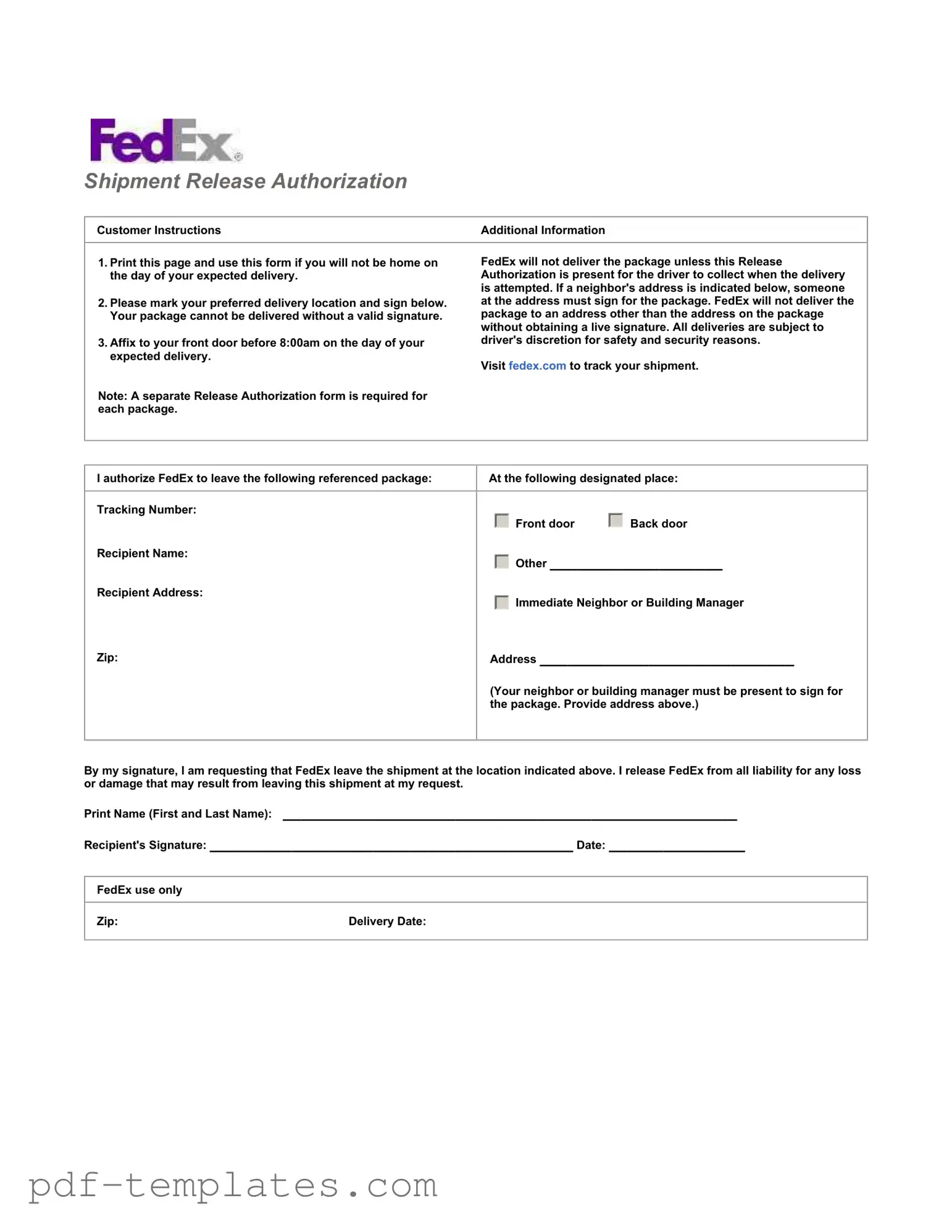The FedEx Release form shares similarities with a UPS Release form. Both documents serve the purpose of authorizing a delivery service to leave a package at a specified location when the recipient is unavailable. Each form requires the recipient's signature to confirm that they accept responsibility for the package once it is left at the designated spot. Additionally, both forms emphasize the importance of providing clear instructions regarding where the package should be left, ensuring that delivery personnel have the necessary guidance to fulfill the request safely.
Another comparable document is the USPS Package Intercept Request. This form allows customers to redirect a package that is already in transit. Like the FedEx Release form, it requires the customer to provide specific details about the package, including tracking numbers and delivery addresses. Both forms aim to facilitate the management of package deliveries while ensuring that the recipient retains some control over the process, even when they are not physically present.
The Amazon Delivery Instructions form also resembles the FedEx Release form. Customers can specify where they would like their packages to be left if they are not home during delivery. This form, like the FedEx version, requires clear communication of preferences and may include a signature to acknowledge the recipient's acceptance of the delivery terms. Both forms aim to enhance convenience for the customer while ensuring the delivery service has adequate instructions to follow.
A similar document is the DHL Delivery Release Authorization. This form allows customers to authorize DHL to leave packages at a specified location when they are unavailable to sign for them. It requires the recipient to specify their preferred drop-off location and provides a legal release of liability for the courier. Both the DHL and FedEx forms highlight the necessity of clear instructions and the importance of a signature to confirm the recipient's consent.
The Signature Release form used by local courier services also parallels the FedEx Release form. This document allows customers to permit a courier to leave a package without a signature when the recipient is not available. Both forms require the recipient to indicate a preferred delivery location and to accept responsibility for the package once it is left. This shared focus on convenience and liability release underscores the common purpose of these documents.
In the realm of rental agreements, the Tenant Package Release form bears resemblance to the FedEx Release form. This document allows tenants to authorize a property manager or landlord to accept deliveries on their behalf. Like the FedEx form, it emphasizes the importance of clear communication regarding where packages should be left and includes a signature to affirm the tenant's consent. Both forms are designed to facilitate package delivery while addressing liability concerns.
The Authorization for Release of Information form used in various service industries also shares similarities with the FedEx Release form. This document allows individuals to grant permission for specific information to be shared with a third party. Both forms require a signature to validate the authorization and emphasize the importance of clarity in specifying what is being authorized. The underlying principle of consent and responsibility connects these two documents.
The Package Delivery Waiver form used by some delivery services also resembles the FedEx Release form. This document allows customers to waive the requirement for a signature upon delivery, permitting the courier to leave the package at a designated location. Both forms require the recipient to specify their preferences and to acknowledge their acceptance of the associated risks. This focus on customer choice and liability release is a common theme.
The Release of Liability form used in event planning also shares similarities with the FedEx Release form. This document allows participants to acknowledge the risks involved in an event and to release the organizers from liability. Both forms require a signature to confirm understanding and acceptance of the terms. The emphasis on informed consent and personal responsibility connects these two types of documents.
Lastly, the Delivery Authorization form used by grocery delivery services is akin to the FedEx Release form. This document allows customers to authorize delivery personnel to leave groceries at a specified location when they are not home. Similar to the FedEx form, it requires clear instructions and a signature to confirm the recipient's consent. Both forms aim to provide flexibility and convenience for customers while addressing the associated liability concerns.
